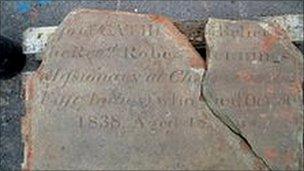Gloucester Linkages dig team excited at gravestone find
- Published

The inscription records the death of Catherine Jennings who died in 1838, aged 48
Archaeologists working on a £7m traffic project in Gloucester have uncovered an historically significant gravestone.
The headstone was found down a well and is believed to have come from a burial ground of a chapel in Southgate Street.
The team was working on the Linkages project to improve access between the city centre and new Quays complex.
The gravestone inscription records the death of Catherine Jennings in 1838, aged 48. County archaeologists said it was an "exciting" discovery.
The inscription also refers to Catherine's husband, the Reverend Robert Jennings, who was a missionary at Chittoor in the East Indies - now modern day India.
Gloucestershire County Council said research has established that he was born in 1797, served as a minister in Gloucester and was appointed as a missionary by the London Missionary Society in 1827.
He died in Chittoor on 1 June 1831, aged 34, leaving his widow and a child to return to England.
Records show that the couple had a daughter, Harriet Jennings, who lived in The Promenade, Cheltenham.
She was married twice - first to Gloucester lawyer Thomas Avery and then to Edwin Broad, the uncle of the philosopher C.D. Broad.
Harriet died at the age of 80 in 1911.
The team believe this may mean her mother's relatives could still be living in the county.
Paul Nichols, senior project officer in the archaeology team, said: "Finds like this really bring the past to life and it's exciting to think that some of Catherine's relatives may still live locally.
"The amazing range of finds we have had so far from the Linkages scheme really emphasise Gloucester's rich heritage and we hope to discover more as we continue to monitor the project."
The find comes just weeks after two medieval skeletons were unearthed by the Linkages workmen at Kimbrose Triangle.